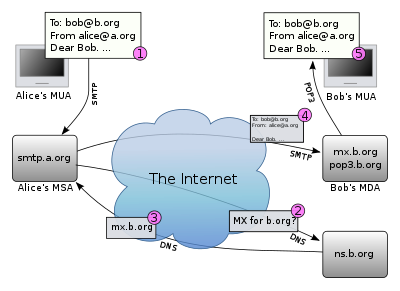This article is about the communications medium. For the former manufacturing conglomerate, see Email Limited.
Electronic mail, commonly called email or e-mail, is a method of exchanging digital messages from an author to one or more recipients. Modern email operates across the Internet or other computer networks. Some early email systems required that the author and the recipient both be online at the same time, in common with instant messaging. Today's email systems are based on a store-and-forward model. Email servers
accept, forward, deliver and store messages. Neither the users nor
their computers are required to be online simultaneously; they need
connect only briefly, typically to an email server, for as long as it takes to send or receive messages.An email message consists of three components, the message envelope, the message header, and the message body. The message header contains control information, including, minimally, an originator's email address and one or more recipient addresses. Usually descriptive information is also added, such as a subject header field and a message submission date/time stamp.
Originally a text-only (7-bit ASCII and others) communications medium, email was extended to carry multi-media content attachments, a process standardized in RFC 2045 through 2049. Collectively, these RFCs have come to be called Multipurpose Internet Mail Extensions (MIME).
Electronic mail predates the inception of the Internet, and was in fact a crucial tool in creating it,[2] but the history of modern, global Internet email services reaches back to the early ARPANET. Standards for encoding email messages were proposed as early as 1973 (RFC 561). Conversion from ARPANET to the Internet in the early 1980s produced the core of the current services. An email sent in the early 1970s looks quite similar to a basic text message sent on the Internet today.
Spelling
Electronic mail has several English spelling options that occasionally prove cause for surprisingly vehement disagreement.[3][4]- email is the form required by IETF Requests for Comment and working groups[5] and increasingly by style guides.[6][7][8] This spelling also appears in most dictionaries.[9][10][11][12][13][14]
- e-mail is a form previously recommended by some prominent journalistic and technical style guides. According to Corpus of Contemporary American English data, this form appears most frequently in edited, published American English writing.[15]
- mail was the form used in the original RFC. The service is referred to as mail and a single piece of electronic mail is called a message.[16][17][18]
- eMail, capitalizing only the letter M, was common among ARPANET users and the early developers of Unix, CMS, AppleLink, eWorld, AOL, GEnie, and Hotmail.[citation needed]
- EMail is a traditional form that has been used in RFCs for the "Author's Address",[17][18] and is expressly required "for historical reasons".[19]
- E-mail is sometimes used, capitalizing the initial letter E as in similar abbreviations like A-bomb, H-bomb, and C-section.[20]
Origin
Precursors
Sending text messages electronically could be said to date back to the Morse code telegraph of the mid 1800s; and the 1939 New York World's Fair, where IBM sent a letter of congratulations from San Francisco to New York on an IBM radio-type, calling it a high-speed substitute for mail service in the world of tomorrow.[21] Teleprinters were used in Germany during World War II[22], and use spread until the late 1960s when there was a worldwide Telex network. Additionally, there was the similar but incompatible American TWX, which remained important until the late 1980s.[23]Host-based mail systems
With the introduction of MIT's Compatible Time-Sharing System (CTSS) in 1961[24] for the first time multiple users were able to log into a central system[25] from remote dial-up terminals, and to store, and share, files on the central disk.[26]Informal methods of using this to pass messages developed—and were expanded to create the first true email system:
Other early time-sharing system soon had their own email applications:
- 1972 - Unix mail program[28][29]
- 1972 - APL Mailbox by Larry Breed[30][31]
- 1981 - PROFS by IBM
- 1982 - ALL-IN-1[32] by Digital Equipment Corporation
Email networks
Soon systems were developed to link compatible mail programs between different organisations over dialup modems or leased lines, creating local and global networks.- In 1971 the first ARPANET email was sent,[33] and through RFC 561, RFC 680, RFC 724—and finally 1977's RFC 733, became a standardized working system.
- Unix mail was networked by 1978's uucp,[34] which was also used for USENET newsgroup postings
- IBM mainframe email was linked by BITNET in 1981
- IBM PC's running DOS in 1984 could link with FidoNet for email and shared bulletin board posting
Operation overview
The diagram to the right shows a typical sequence of events[40] that takes place when Alice composes a message using her mail user agent (MUA). She enters the email address of her correspondent, and hits the "send" button.
- Her MUA formats the message in email format and uses the Submission Protocol (a profile of the Simple Mail Transfer Protocol (SMTP), see RFC 4409) to send the message to the local mail submission agent (MSA), in this case smtp.a.org, run by Alice's internet service provider (ISP).
- The MSA looks at the destination address provided in the SMTP protocol (not from the message header), in this case bob@b.org. An Internet email address is a string of the form localpart@exampledomain. The part before the @ sign is the local part of the address, often the username of the recipient, and the part after the @ sign is a domain name or a fully qualified domain name. The MSA resolves a domain name to determine the fully qualified domain name of the mail exchange server in the Domain Name System (DNS).
- The DNS server for the b.org domain, ns.b.org, responds with any MX records listing the mail exchange servers for that domain, in this case mx.b.org, a message transfer agent (MTA) server run by Bob's ISP.
- smtp.a.org sends the message to mx.b.org using SMTP.
- The MDA delivers it to the mailbox of the user bob.
- Bob presses the "get mail" button in his MUA, which picks up the message using either the Post Office Protocol (POP3) or the Internet Message Access Protocol (IMAP4).
- Alice or Bob may use a client connected to a corporate email system, such as IBM Lotus Notes or Microsoft Exchange. These systems often have their own internal email format and their clients typically communicate with the email server using a vendor-specific, proprietary protocol. The server sends or receives email via the Internet through the product's Internet mail gateway which also does any necessary reformatting. If Alice and Bob work for the same company, the entire transaction may happen completely within a single corporate email system.
- Alice may not have a MUA on her computer but instead may connect to a webmail service.
- Alice's computer may run its own MTA, so avoiding the transfer at step 1.
- Bob may pick up his email in many ways, for example logging into mx.b.org and reading it directly, or by using a webmail service.
- Domains usually have several mail exchange servers so that they can continue to accept mail when the main mail exchange server is not available.
- Email messages are not secure if email encryption is not used correctly.
Message format
The Internet email message format is defined in RFC 5322, with multi-media content attachments being defined in RFC 2045 through RFC 2049, collectively called Multipurpose Internet Mail Extensions or MIME. Prior to the introduction of RFC 2822 in 2001, the format described by RFC 822 was the standard for Internet email for nearly 20 years. RFC 822 was published in 1982 and based on the earlier RFC 733 for the ARPANETInternet email messages consist of two major sections:
- Header — Structured into fields such as From, To, CC, Subject, Date, and other information about the email.
- Body — The basic content, as unstructured text; sometimes containing a signature block at the end. This is exactly the same as the body of a regular letter.
Message header
Each message has exactly one header, which is structured into fields. Each field has a name and a value. RFC 5322 specifies the precise syntax.Informally, each line of text in the header that begins with a printable character begins a separate field. The field name starts in the first character of the line and ends before the separator character ":". The separator is then followed by the field value (the "body" of the field). The value is continued onto subsequent lines if those lines have a space or tab as their first character. Field names and values are restricted to 7-bit ASCII characters. Non-ASCII values may be represented using MIME encoded words.

Tidak ada komentar:
Posting Komentar